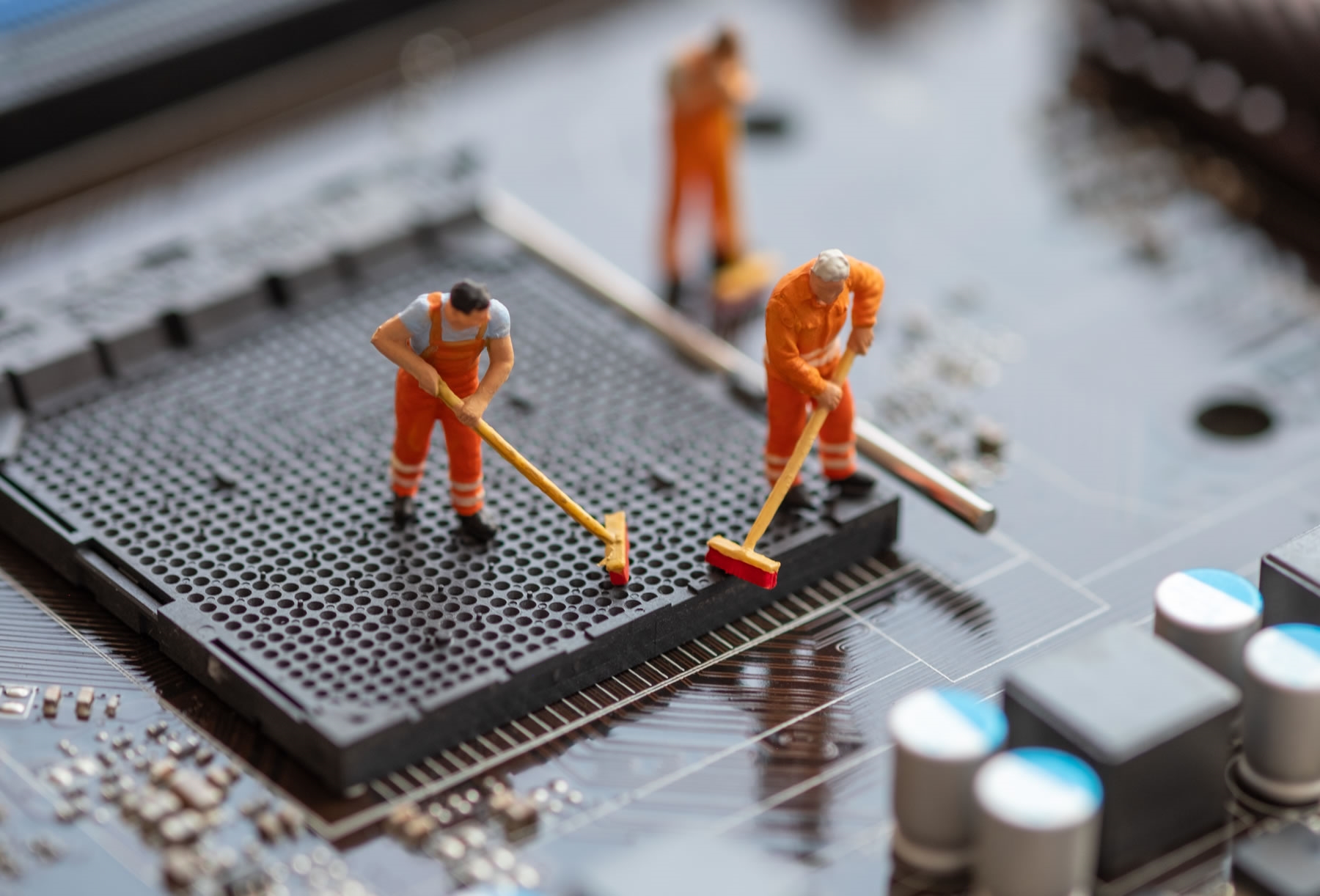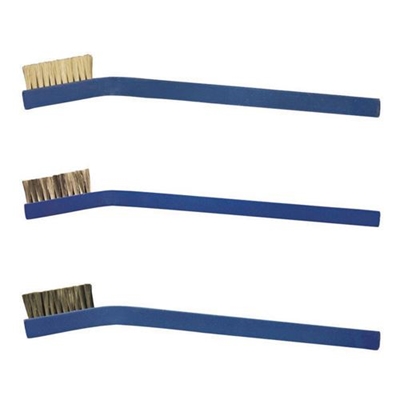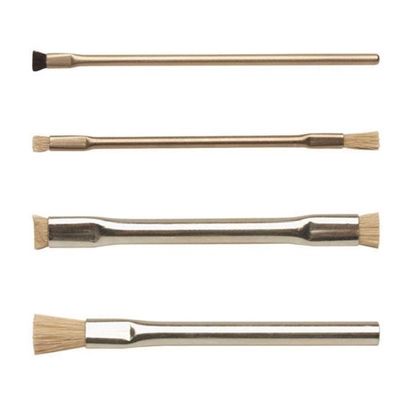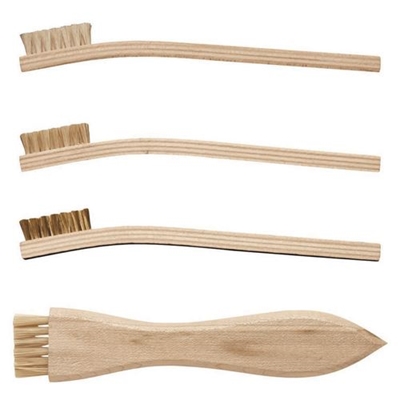When cleaning sensitive devices and electronics, including printed circuit boards, the safest method is to allow the solvent to its job without additional agitation. Unfortunately, with oxidation, heavy greases, and other tenacious soils, there is no substitute for a technical cleaning brush. The article covers brush specifications, bristle types, and special considerations when working with precision cleaning brushes.
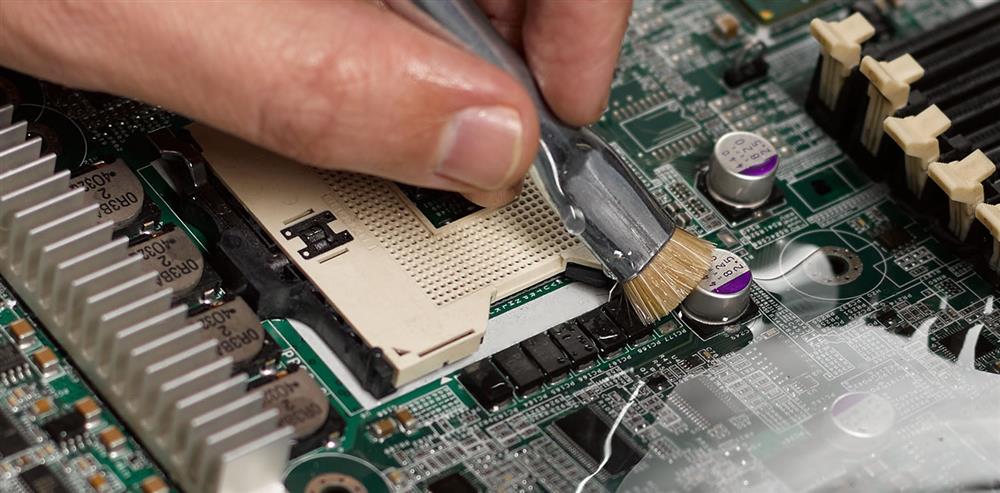
Brush Design Specification
When selecting a brush for your application, the first challenge is to interpret the dimensions. Brush dimensions are expressed in length (L), width (w), and trim (T) (see fig. 1). Length and width are the dimension of the bristle groupings, and impact the amount of cleaning precision possible from the particular brush. Small brushes, similar to fine art paint brushes, are available for cleaning dense circuit board designs. Brushes are also available for larger applications, like sweeping debris from broad surfaces.
Trim is the length of the bristle from the handle. This directly affects the touch or stiffness of the bristles. Shorter trimmed brushes generally have a firmer touch and are better for more aggressive cleaning. Bristles are often trimmed straight, but can be trimmed in a rounded, or conical shape, and even angled. Techspray offers brushes that are angled to a point, for cleaning that is both precise and aggressive.
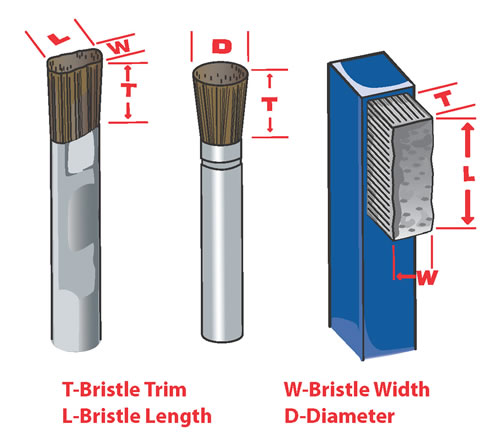
Brush Bristle Type
The type of bristle has a major impact on whether a brush is better for fine work, like conformal coating touch-up, or aggressive scrubbing:
- Goat hair – Goat hair is fine and soft, but fairly inelastic. It is naturally kinked, so is normally used for short bristled brushes like for cosmetics and in “acid” brushes commonly used for applying conformal coating in quality control rework. Natural hair brushes are considered static neutral, so are better suited for sensitive electronics than nylon bristles, like those found in common toothbrushes.
- Hog bristle – Hog bristles are stiff and ideal for more aggressive scrubbing. They are also very durable and water resistant. Natural hair brushes are considered static neutral, so are better suited for sensitive electronics than nylon bristles.
- Horse hair – Horse hair is slightly stiff and allows for dry cleaning without the risk of scratching. It is also durable and absorbent, so able to carry away liquids in a cleaning process. Horse hair is not resistant to acids or alkalis. Natural hair brushes are considered static neutral, so are better suited for sensitive electronics than nylon bristles.
- Brass wire – Brass is the softest metal available for brushes. Brass brushes are used for more aggressive cleaning and finishing work.
- Stainless steel wire – Stainless steel wire brushes provide very aggressive cleaning, deburring, removing rust, and surface roughing, like preparation for epoxy adhesive. These bristles are very corrosion and heat resistant. Sulfuric acid, commonly used as an industrial cleaning agent for removing rust and grease, should not be used with stainless steel brushes. Some types of inks can also react to stainless steel fibers. For those types of applications, natural fiber brushes are recommended.
Avoid Hair Loss with Quality Brushes
A frequent complaint with brushes is hair loss. This is a common problem with low cost, disposable brushes. A cheap acid brush used in quality control retouch of conformal coating can actually lead to FOD (foreign object debris), a defect than can actually reduce the service life of electronic devices.
Wire drawn, or hand laced brushes are made by sewing the brush filaments into place with metal wire or nylon cable. This method involves tying the wire or cable around the middle of the bristle and bending it in half. The wire and bend point is then drawn through the core’s pre-drilled holes and secured with a knot to lock the tuft into place. Wire drawing is an extremely secure method of attaching the filament tuft to the core and requires extensive labor as each tuft must be individually placed and secured.
Cleanliness of Natural Bristle Brushes
Not many people will look at a horse or hog and say “I want to clean my sensitive electronics with THAT”. Techspray takes special care to ensure our natural fiber brushes are clean and free of contamination.
The horse and hog hair used in Techspray brushes are “dressed”, meaning cleaned, sterilized, combed, and bundled. Horse hair is sterilized using steam in an autoclave at 257°F (125°C) or higher, for at least 45 minutes. For hog hair, this procedure requires sterilization with boiling water or steam of at least 212°F (100°C) for 2 hour or longer.
These cleaning processes meet or exceed sterilization requirements of the US Department of Agriculture for manufacturing brushes.
ESD Effects from Brush Design
When cleaning sensitive electronics, close attention needs to be paid to whether or not a brush can be grounded, or at least not generate a static charge. With this in mind, it is surprisingly common to find consumer-grade toothbrushes on electronic PCB rework and repair workbenches.
Natural hair brushes are considered static neutral, so are better suited for sensitive electronics than nylon bristles, like those found in common toothbrushes.
Conductive brush materials, like brass and stainless steel bristles, have surface resistivity less than 1 x 105 Ω/sq or a volume resistivity less than 1 x 104 Ω-cm, so allow electrons to move freely. If both bristles and handle are conductive, brushes are grounded if the operator uses a wrist or heel strap to connect to a common ground point. A common misconception is that conductive brushes cannot generate a charge. If ungrounded, there is still a risk of generating and holding a static charge, which can lead to a damaging ESD event.
Techspray Technical Cleaning Brushes
Techspray's TechClean brushes are made of premium grade materials. Don't be fooled by cheap imports. The bristles on our cleaning brushes are securely stapled in place, eliminating loose hairs. Choose the Right Bristle Material for Your Needs:
- Natural — Soft, resilient and long lasting. Hog bristles are stiffer than horse hair.
- Metal — For burnishing, polishing, non-sparking static dissipation and deburring. Brass is a softer bristle than stainless steel.
General Cleaning Brushes - A wide variety of sizes and bristle material for general maintenance cleaning. All handles are made of strong, static neutral wood.
Static Sensitive Brushes - Ideal for cleaning static sensitive electronics or components. Anodized aluminum falls within the static dissipative range. Steel bristles are conductive, and horse hair is dissipative when saturated with solvent.
Technical Brushes - Small, precision brushes for technical cleaning and coating or adhesive application. Double-sided brushes include tapered end for tight areas. Five tons of pressure are applied to each metal brush handle to ensure that the bristles remain intact during the most rigorous applications. Bristles securely stapled to prevent bristle loss. Two brushes have horse hair bristles that are trimmed at a tapered angle for cleaning tight areas, like along the sides of a BGA or other low stand-off components.
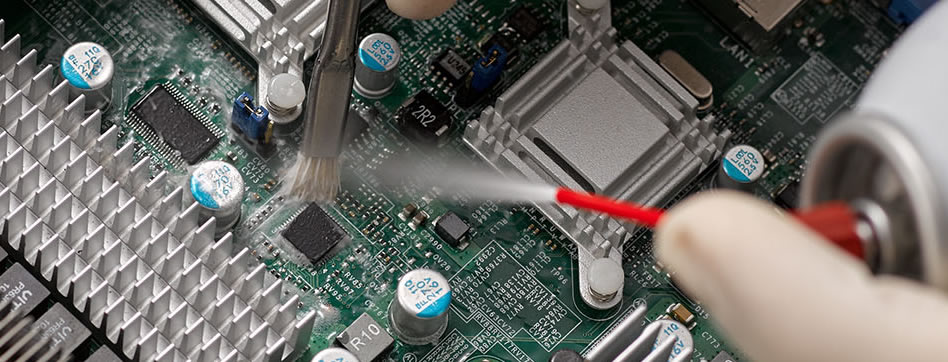
Brush Attachments for Aerosol Cleaners
Some Techspray flux removers include a horse hair brush attachment. This fits over the actuator (spray nozzle), allowing the operator to scrub a PCB surface as the solvent cleaner is sprayed. The solvent passes through an embedded needle and then through the brush in a controlled fashion. The end result is more aggressive cleaning with minimal solvent usage. To ensure proper removal of flux residues once they are dissolved and separated from the board’s or component’s surface, the brush can be used over an absorbent wipe. A final rinse, holding the PCB at an angle to allow for proper flow of the solvent solution, is recommended for critical electronics.
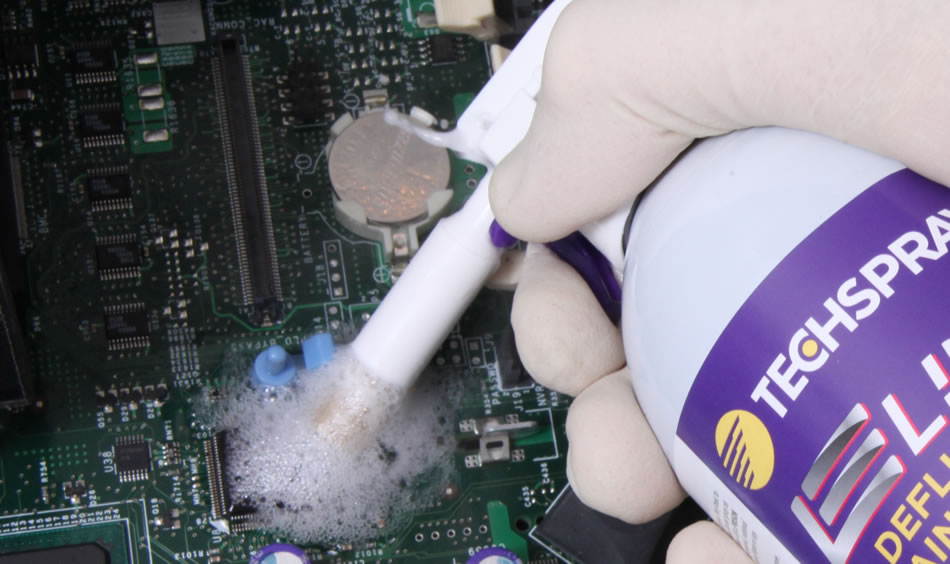
For more information, call 800-858-4043 or email info@itwcce.com.
Source: Gordon Brush – www.gordonbrush.com

